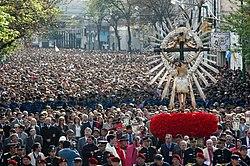
Back الرومانية الكاثوليكية في الأرجنتين Arabic Katolická církev v Argentině Czech Römisch-katholische Kirche in Argentinien German Iglesia católica en Argentina Spanish Église catholique en Argentine French Gereja Katolik di Argentina ID Chiesa cattolica in Argentina Italian Katholieke Kerk in Argentinië Dutch Igreja Católica na Argentina Portuguese Католицизм в Аргентине Russian
Catholic Church in Argentina | |
|---|---|
| Spanish: Iglesia católica en Argentina | |
 | |
| Type | National polity |
| Classification | Catholic |
| Orientation | Latin |
| Scripture | Bible |
| Theology | Catholic theology |
| Polity | Episcopal |
| Governance | CEA |
| Pope | Francis |
| Primate | Mario Aurelio Poli |
| Region | Argentina |
| Language | Spanish, Latin |
| Origin | 17th century[1] Colonial Argentina, Spanish Empire |
| Members | 48.9%[2] of Argentina's population |
| Official website | CEA |
| Part of a series on the |
| Catholic Church by country |
|---|
 |
|
|


The Argentine Catholic Church, or Catholic Church in Argentina, is part of the worldwide Catholic Church, under the spiritual leadership of the pope, the Curia in Rome, and the Argentine Episcopal Conference.[citation needed]
According to the CIA World Factbook (July 2014), 92% of the country are nominally Catholic, but less than 20% practice their faith regularly (i.e., attend weekly Mass).[3] Later studies in 2019 suggest that between 62.9%[4] and 63.3%[5] of Argentinians are Catholic. No study has yet determined whether Catholics with higher levels of traditional religious observance are more likely than those with lower levels to participate in any cultural Catholic activities such as participating in online conversations about Catholicism's customs, beliefs, etc., sharing Catholic holidays with family, or engaging in political and social activism as an expression of Catholicism. In 2020, such a study was made of American Jews, comparing and contrasting nominally Jewish adherents with those who practice their faith weekly.[6][7]
Today, the church in Argentina is divided into administrative territorial units called dioceses and archdioceses. Buenos Aires, for example, is a metropolitan archdiocese owing to its size and historical significance as the capital of the nation.
An archbishop of Buenos Aires, Cardinal Jorge Bergoglio (now Pope Francis), SJ, was elected as pope on 13 March 2013. Buenos Aires Metropolitan Cathedral, the seat of the archbishop, also houses the remains of General José de San Martín in a mausoleum.[8]
There are eight Catholic universities in Argentina: Pontifical Catholic University of Argentina (Buenos Aires), the Universidad Católica de Córdoba, the Universidad Católica de La Plata, the Universidad Católica de Salta, the Universidad Católica de Santa Fe, the Universidad Católica de Cuyo, the Universidad Católica de las Misiones, and the Catholic University of Santiago del Estero.
- ^ "Argentine Culture – Religion". 2018.
- ^ "Catholicism and evangelism: the two most common religions in Latin America". Statista. 26 October 2022. Retrieved 9 December 2022.
- ^ "CIA World Factbook – Argentina – People and Society". Retrieved 12 July 2014. see also Religions – Argentina
- ^ Cite error: The named reference
2019 surveywas invoked but never defined (see the help page). - ^ "Latinobarómetro Database". www.latinobarometro.org.
- ^ "Jewish Americans in 2020," Pew Research Center, Religion and Public Life, 5/16/2021.
- ^ Also see Michelle Dillon's Catholic Identity: Balancing Reason, Faith, and Power (Cambridge: Cambridge University Press, 1999); Philip Hammond's article in "Religion and the Persistence of Identity" in the Journal for the Scientific Study of Religion, 27 (1988), 1–11, and Peter Burke, "Introductions," in Burke et al., eds., Advances in Identity Theory and Research (New York, 2003) 1–10. And finally, for a more nuanced treatment of Catholic identity within the defined geographical and temporal context of early 20th century Boston (US), see Paul Kane's Separatism and Substructure: Boston Catholicism, 1900–1920 (Chapel Hill, 1994). These sources point out that religious institutions, observance data, and structures have never been the sole source of the religious narratives of any faith (not just Jewish) that serve to structure the identities of individual adherents.
- ^ Atlas Obscura website
© MMXXIII Rich X Search. We shall prevail. All rights reserved. Rich X Search